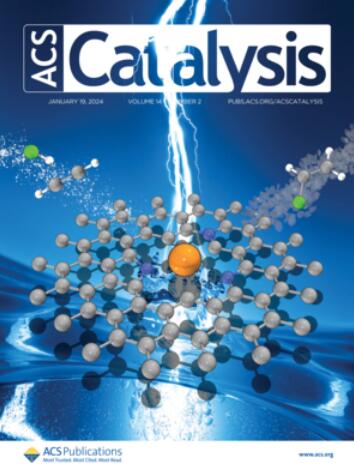稀土元素掺入沸石催化剂的结构与功能研究
IF 13.1
1区 化学
Q1 CHEMISTRY, PHYSICAL
引用次数: 0
摘要
稀土元素(REE)掺入脱铝沸石已被证明可以催化多种选择性氧合物转化,包括乙醇到烯烃,但REE掺入的Lewis酸型的结构和功能尚不清楚。在这项研究中,我们提出了五种钇酸位构型,并通过实验物理化学表征技术(包括x射线吸收光谱和吡啶傅里叶变换红外光谱(FTIR))对每种构型进行了评估。我们的分析确定了三个基本的位点基序,缺陷开放,脱水缺陷开放和双羟基,由邻近的硅烷醇缺陷和羟基稳定,符合光谱表征。通过比较乙醇脱水动力学,我们确定了可转换缺陷打开和脱水缺陷打开位点与催化周转动力学相关。Y/deAlBeta中的三个钇开放位结构基序被扩展到14个其他稀土元素(La, Ce, Pr, Nd, Sm, Eu, Gd, Tb, Dy, Ho, Er, Tm, Yb和Lu),以探索Lewis酸强度的趋势,通过吡啶吸附能进行评估,并通过实验测量的吡啶红外光谱进行支持。建立了Lewis酸强度与最高已占据分子轨道能量+最低未占据分子轨道能量之间的线性关系,为理解脱铝Beta型稀土的结构-功能关系提供了预测框架。这些发现提供了分子水平上的REE掺入及其在调节Lewis酸强度中的作用,以选择性催化将生物质衍生的含氧化合物转化为化学品和液体燃料。本文章由计算机程序翻译,如有差异,请以英文原文为准。
Exploring the Structure and Function of Rare-Earth Elements Incorporated into Zeolite Catalysts
Rare-earth element (REE) incorporation into dealuminated zeolites has been shown to catalyze a variety of selective oxygenate transformations, including ethanol to olefins, yet the structure and function of REE-incorporated Lewis acid zeotypes remain unclear. In this study, we proposed five yttrium acid site configurations and evaluated each against experimental physicochemical characterization techniques including X-ray absorption spectroscopy and pyridine Fourier transformed infrared spectroscopy (FTIR). Our analysis identified three fundamental site motifs, defect-open, dehydrated defect-open, and geminal hydroxyl, stabilized by adjacent silanol defects and hydroxyl groups that agreed with spectroscopic characterization. By comparing ethanol dehydration kinetics, we identified that interconvertible defect-open and dehydrated defect-open sites are kinetically relevant for catalytic turnovers. The three yttrium open site structural motifs from Y/deAlBeta were extended to 14 other REEs (La, Ce, Pr, Nd, Sm, Eu, Gd, Tb, Dy, Ho, Er, Tm, Yb, and Lu) to explore trends in Lewis acid strength, assessed via pyridine adsorption energies and supported by experimentally measured pyridine FTIR. A linear correlation between Lewis acid strength and highest occupied molecular orbital + lowest unoccupied molecular orbital energies was established, offering a predictive framework for understanding structure–function relationships in REEs incorporated into dealuminated Beta zeotypes. These findings provide molecular-level insight into REE incorporation and its role in tuning Lewis acid strength for the selective catalytic transformation of biomass-derived oxygenates into chemicals and liquid fuels.
求助全文
通过发布文献求助,成功后即可免费获取论文全文。
去求助
来源期刊

ACS Catalysis
CHEMISTRY, PHYSICAL-
CiteScore
20.80
自引率
6.20%
发文量
1253
审稿时长
1.5 months
期刊介绍:
ACS Catalysis is an esteemed journal that publishes original research in the fields of heterogeneous catalysis, molecular catalysis, and biocatalysis. It offers broad coverage across diverse areas such as life sciences, organometallics and synthesis, photochemistry and electrochemistry, drug discovery and synthesis, materials science, environmental protection, polymer discovery and synthesis, and energy and fuels.
The scope of the journal is to showcase innovative work in various aspects of catalysis. This includes new reactions and novel synthetic approaches utilizing known catalysts, the discovery or modification of new catalysts, elucidation of catalytic mechanisms through cutting-edge investigations, practical enhancements of existing processes, as well as conceptual advances in the field. Contributions to ACS Catalysis can encompass both experimental and theoretical research focused on catalytic molecules, macromolecules, and materials that exhibit catalytic turnover.
 求助内容:
求助内容: 应助结果提醒方式:
应助结果提醒方式:


